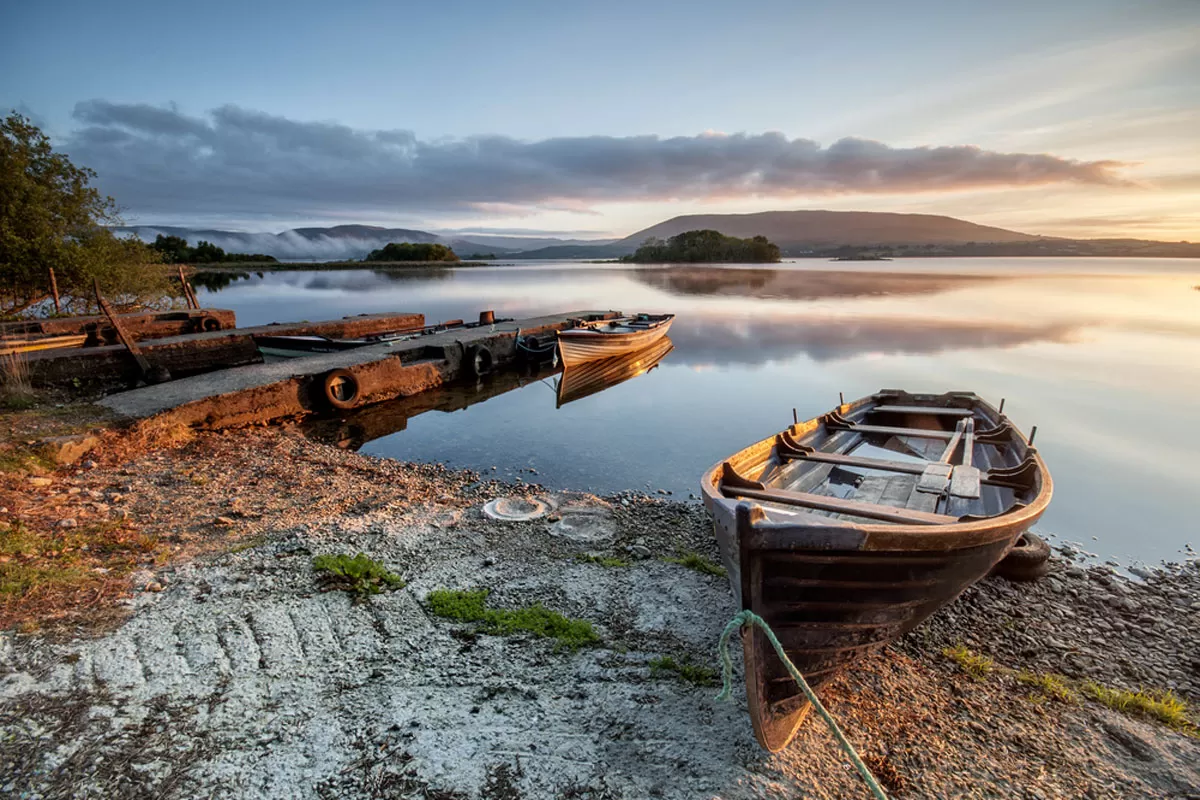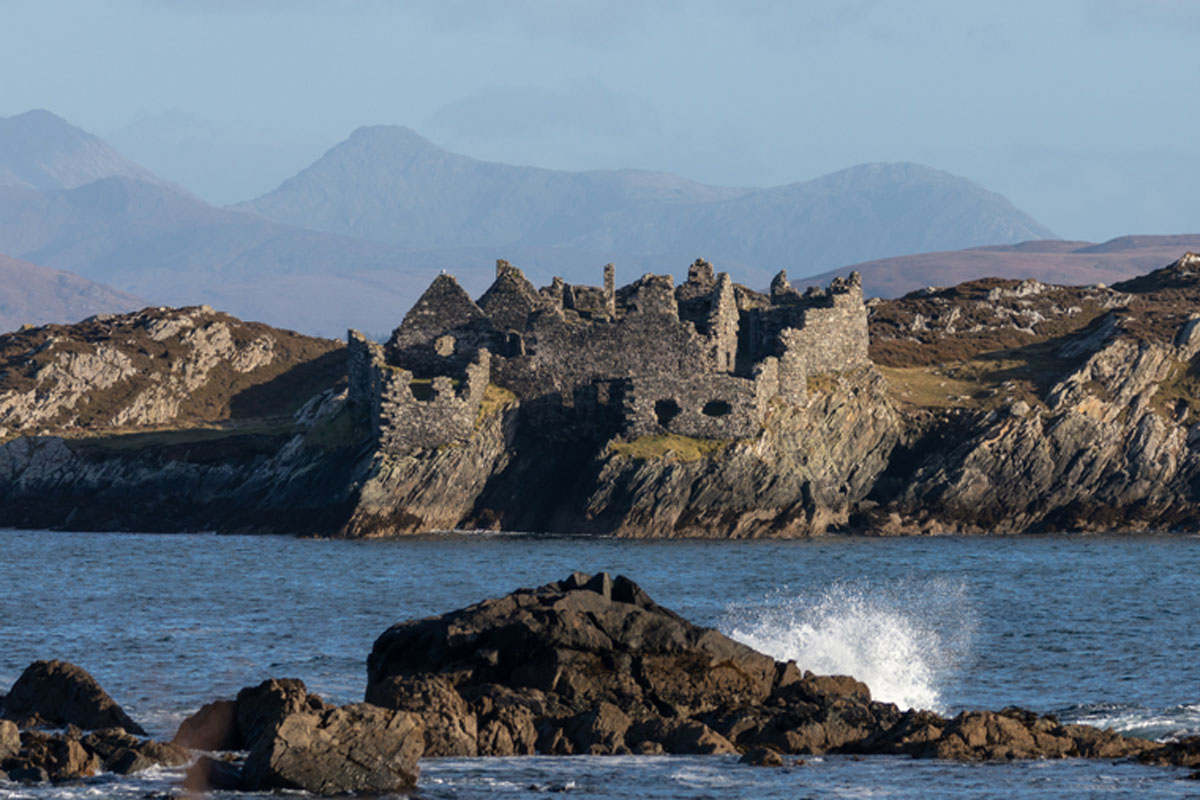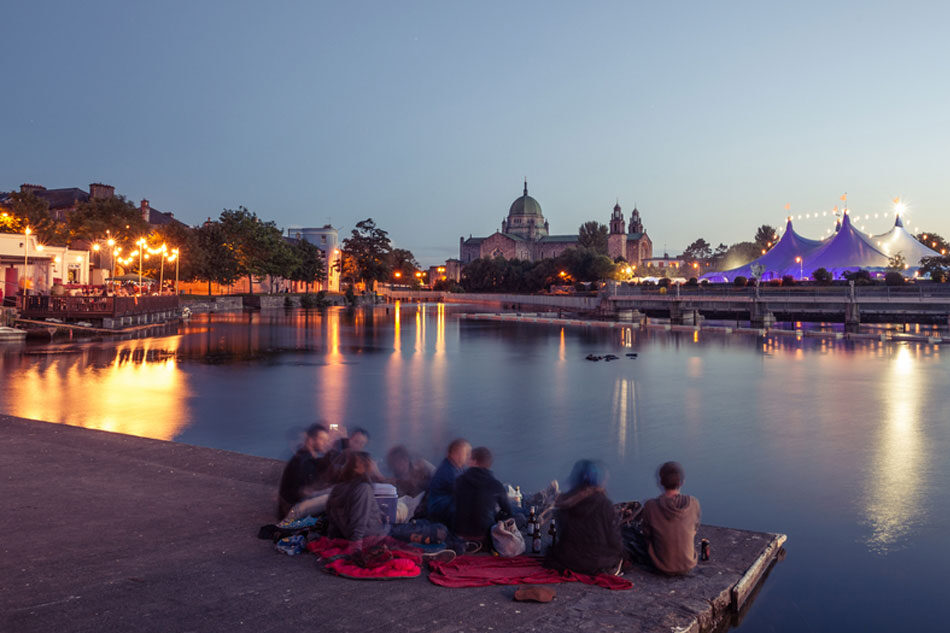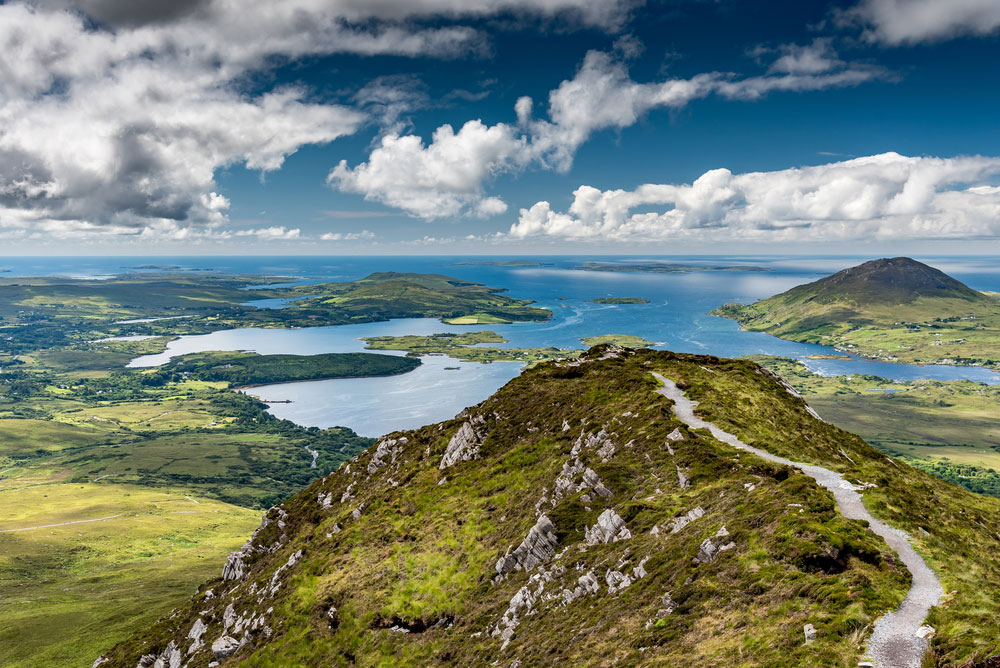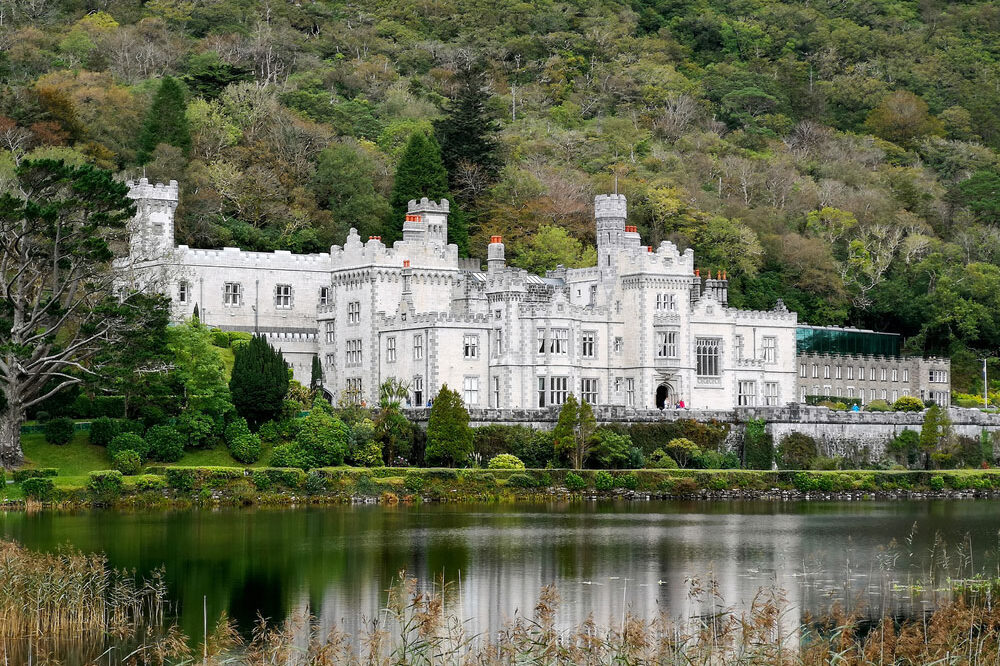An Introduction to the Ancient Fortress
Perched on the edge of a cliff on Inis Mór, the largest of the Aran Islands, Dún Aonghasa (Dun Aengus) is one of Ireland’s most striking ancient sites. This prehistoric stone fort, dating back over 3,000 years, captures the rugged spirit of the Irish landscape and the mystery of its ancient inhabitants.
Origins and History
Dún Aonghasa was likely constructed during the Bronze Age, around 1100 BCE, though archaeological evidence suggests that human activity in the area predates the fort’s construction. Named after the mythical Irish king Aonghus, the fortress has served as both a defensive stronghold and a place of ceremonial importance. Its walls and structure have withstood thousands of years of erosion, symbolizing the enduring strength of Ireland’s ancient past.
Location and Setting
Set 100 meters above the Atlantic Ocean, Dún Aonghasa is renowned for its breathtaking location atop sheer cliffs. The fort offers panoramic views of the sea and the Aran Islands, making it a focal point for both tourists and historians. This site’s isolated setting has preserved its sense of timelessness, inviting visitors to step back into a world where ancient rituals and communal life were rooted in nature’s vast beauty.
Significance in Irish Culture
The mystique surrounding Dún Aonghasa is deeply intertwined with Irish folklore and mythology. Often considered a symbol of resilience and unity, the fortress has inspired artists, writers, and filmmakers alike. It stands as a testament to Ireland’s rich cultural heritage, its survival through centuries of change, and the importance of preserving its past.
Architecture and Defensive Design
The architectural design and defensive features make Dún Aonghasa a marvel of ancient engineering. The structure showcases the strategic planning of its builders, combining natural elements with human-made defenses to create a formidable stronghold on the edge of Inis Mór’s cliffs.
Layout and Structure
Dún Aonghasa is a semi-circular stone fort, with its open side facing inland and its rear backed by the sheer cliff face, creating a natural defense against enemies approaching from the sea. The fort is divided into multiple sections, or “rings,” each with a distinct purpose. Three main walls encircle the interior, forming a series of enclosures that would have protected those within the fort while also providing a place for community gatherings and ceremonies.
The outer walls, reaching over four meters in height and two meters thick in some sections, are built from limestone slabs, creating a barrier that would have deterred invaders. The design shows both functionality and the practical use of local materials, reflecting a deep understanding of the local landscape.
Chevaux-de-Frise: A Unique Defense
One of the most notable defensive features of Dún Aonghasa is its chevaux-de-frise—a dense arrangement of upright, jagged stones placed outside the main wall. This field of stones would have made it extremely difficult for enemies to approach the fortress, serving as a barrier to both foot soldiers and, potentially, animals. The chevaux-de-frise showcases the ingenuity of the fort’s builders, who used natural resources in creative ways to secure the site.
Entrances and Pathways
The entrance to Dún Aonghasa is carefully designed, with narrow pathways leading through the outer walls, making it easier to defend against intruders. The passages are aligned to funnel visitors into smaller enclosures, allowing defenders to control the flow of people entering the fort. These narrow entrances would have made it nearly impossible for an invading force to launch a large-scale assault, adding another layer of security to the fortress.
The architectural layout and defensive design of Dún Aonghasa reveal much about the people who built it. The combination of natural barriers and intricate stonework not only protected the community but also underscored their ingenuity and resourcefulness.
Life and Rituals Within the Fortress
While the massive stone walls and defensive features of Dún Aonghasa hint at a fortress built for protection, the site also played an important social and ceremonial role in the lives of its ancient inhabitants.
Everyday Life Inside Dún Aonghasa
The people of Dún Aonghasa lived in a rugged environment, relying on the sea and land for sustenance. While archaeological evidence is limited, it suggests that life within the fortress involved fishing, hunting, and small-scale farming. The fort’s thick walls provided shelter from harsh winds, allowing families to gather for meals and work on crafts, tools, and clothing. Small stone huts likely served as living spaces, with hearths for cooking and warmth, while open areas within the enclosures may have been used for communal activities, gatherings, and teaching survival skills.
The Role of Rituals and Ceremonies
Dún Aonghasa holds significant ceremonial importance, believed to be a site where rituals connected the community to their ancestors and the natural world. Archaeological findings suggest that rituals may have involved offerings to the gods or spirits, celebrating seasonal changes, or marking important life events. The dramatic cliffside location amplifies the sense of awe and mystery, creating an ideal backdrop for ceremonies that might have honored the sea, sky, and elements that governed their lives.
Many researchers believe that Dún Aonghasa served as a pilgrimage or gathering site, where communities from across the Aran Islands came together for festivals, marriages, or rites of passage. The communal nature of these ceremonies would have strengthened social bonds, uniting people in a shared sense of identity and purpose.
Spiritual Beliefs and Folklore
Irish mythology and folklore are rich with stories of fortresses like Dún Aonghasa as sacred spaces inhabited by gods, spirits, or powerful chieftains. It is thought that the people who lived here would have revered their ancestors and believed in a world of spirits closely tied to the land. The fort’s cliffside location may have represented a liminal space, a place where the material and spiritual worlds met, making it ideal for rituals intended to communicate with other realms.
Life within Dún Aonghasa was a blend of survival, community, and reverence for forces beyond human control. From daily chores to spiritual rituals, the people of Dún Aonghasa maintained a deep connection with the land and sea, fortified by a strong sense of community and shared identity.
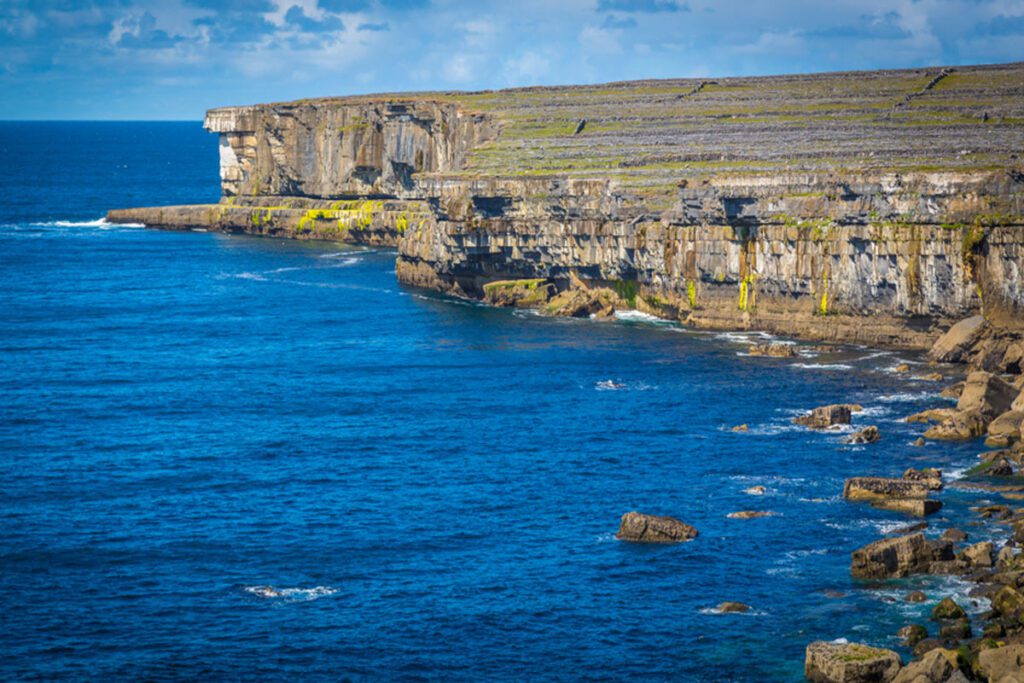
The Natural Surroundings and Landscape of Inis Mór
The stunning natural landscape surrounding Dún Aonghasa is as much a part of the site’s allure as the ancient stone walls themselves. Located on the island of Inis Mór in County Galway, Dún Aonghasa is perched atop a sheer cliff overlooking the Atlantic Ocean, offering sweeping views and an experience of Ireland’s raw natural beauty.
The Cliffs and Atlantic Ocean
Dún Aonghasa sits at the very edge of a 100-meter-high cliff, making the site visually dramatic and naturally fortified. The cliffs, carved over millennia by relentless Atlantic waves, add a sense of both danger and wonder to the site. The vast ocean views provide visitors with a perspective that stretches beyond Inis Mór to the open Atlantic, evoking a feeling of timelessness and isolation that reflects Ireland’s ancient landscapes. This cliffside setting also meant that Dún Aonghasa was vulnerable to erosion, which continues to shape the fort’s structure to this day.
The Unique Karst Landscape
The Aran Islands are known for their distinctive karst landscape, characterized by limestone formations, rocky fields, and narrow fissures. This landscape, formed by the dissolution of limestone over thousands of years, gives Inis Mór a rugged, otherworldly appearance. Visitors to Dún Aonghasa must navigate this rocky terrain, which often adds a sense of adventure and discovery to their journey. The limestone slabs used to build Dún Aonghasa were sourced from this unique landscape, integrating the fort into its environment.
Flora and Fauna of Inis Mór
Despite the seemingly harsh terrain, the island supports a surprising diversity of flora and fauna. Wildflowers, ferns, and rare plants thrive in the cracks of the limestone, creating bursts of color and life against the stark stone background. This delicate ecosystem is home to native birds, such as puffins, ravens, and various seabirds, which add to the site’s wild beauty. The plants and animals of Inis Mór would have been essential resources for the ancient inhabitants, providing food, medicine, and materials for daily life.
Weather and Atmosphere
The ever-changing weather of the Aran Islands plays a significant role in the experience of Dún Aonghasa. Fog, mist, rain, and sunshine can sweep across the landscape within minutes, creating an atmosphere of mystery and unpredictability. On misty days, the fort appears shrouded in clouds, enhancing its mystical presence, while on clear days, the blue Atlantic provides a stunning contrast to the gray stone walls. This dynamic atmosphere has made Dún Aonghasa a favorite spot for photographers, artists, and travelers seeking an authentic experience of Ireland’s coastal beauty.
The natural surroundings of Dún Aonghasa contribute immeasurably to its allure, creating a unique blend of stark beauty, isolation, and wildness. The cliffs, karst landscape, flora, and shifting weather have not only shaped the site physically but have also added layers of meaning and mystery to its cultural significance.
A Modern Symbol of Irish Heritage and Tourism
Today, Dún Aonghasa stands not only as an ancient marvel but also as a popular destination that draws thousands of visitors each year. We will now explore the modern significance of Dún Aonghasa, from its preservation as a historical monument to its impact on Irish tourism, as well as the experience it offers to travelers who come seeking a deeper connection to Ireland’s heritage.
Tourism and Visitor Experience
Dún Aonghasa is one of the most-visited historical sites on the Aran Islands, attracting both international tourists and locals who want to experience Ireland’s early history up close. Reaching the fort involves a scenic hike through Inis Mór’s rugged landscape, a journey that invites visitors to connect with the natural environment surrounding the fortress. Once at the site, visitors encounter panoramic views of the Atlantic, the dramatic cliffs, and the fort’s iconic stone walls, which together create an unforgettable experience. The combination of historical exploration and breathtaking scenery makes Dún Aonghasa a cherished destination.
Preservation and Conservation Efforts
Due to its cliffside location and the natural process of erosion, Dún Aonghasa faces unique conservation challenges. The National Monuments Service of Ireland, along with local organizations, is dedicated to preserving the site, ensuring that its structures remain intact for future generations. Preservation efforts include regular monitoring of erosion, repair work to reinforce the stone walls, and measures to manage visitor impact. These efforts help to maintain the integrity of the fort while also respecting its historical and cultural significance.
Cultural and Symbolic Importance
For many, Dún Aonghasa represents more than a historic site—it embodies Ireland’s resilience, heritage, and connection to ancient traditions. It is often seen as a symbol of Irish identity and the strength of communities who lived in harmony with nature and honored their ancestors. The fort’s survival over millennia has made it a symbol of endurance, inspiring artists, writers, and locals alike who are moved by its timeless presence. As a site steeped in mythology, history, and natural beauty, Dún Aonghasa holds a powerful place in the cultural imagination of Ireland.
Impact on Local Economy
Tourism to Dún Aonghasa also supports the local economy on Inis Mór and the Aran Islands. Guided tours, local businesses, accommodations, and restaurants benefit from the influx of visitors, providing a sustainable income for the island community. This economic boost has helped the island preserve its unique culture, language, and way of life, which are also important draws for tourists.
Dún Aonghasa is a living link to Ireland’s past, blending history, natural beauty, and cultural significance in one extraordinary site. From its origins in the Bronze Age to its place in modern tourism, the fortress continues to captivate and inspire. For those who visit, Dún Aonghasa offers a rare glimpse into the lives of ancient people and a chance to connect with the enduring spirit of Ireland’s heritage.
Natural Attractions
- The Cliffs of Moher – Iconic cliffs offering breathtaking ocean views and a visitor centre.
- Connemara National Park – A vast park with mountains, bogs, and walking trails, including Diamond Hill.
- The Burren – A unique karst landscape with rare flora and archaeological sites.
- Kylemore Abbey and Victorian Walled Garden – A stunning lakeside abbey with beautiful gardens and history.
- Lough Corrib – Ireland’s largest lake, perfect for fishing, boating, and nature exploration.
Historical and Cultural Sites
- Galway City – Known as the “City of Tribes,” with vibrant streets, medieval walls, and Spanish Arch.
- Dunguaire Castle – A picturesque 16th-century castle near Kinvara, hosting medieval banquets.
- Aughnanure Castle – A 16th-century tower house surrounded by scenic landscapes.
- Clifden Castle – Ruins of a 19th-century castle overlooking Clifden Bay.
- Athenry Heritage Centre – An interactive experience showcasing medieval history.
Beaches and Coastal Attractions
- Salthill Promenade – A bustling seaside promenade with stunning views of Galway Bay.
- Dog’s Bay and Gurteen Bay – Beautiful white-sand beaches near Roundstone.
- Spiddal – A coastal village with traditional craft shops and views of the Aran Islands.
- Inishbofin Island – A remote island with beaches, walking trails, and rich history.
- The Aran Islands – Famous for their cultural heritage, stone forts, and rugged landscapes.
Scenic Drives and Villages
- The Sky Road – A panoramic driving route with stunning views of the coastline and islands.
- Clifden – Known as the “Capital of Connemara,” with boutique shops and local restaurants.
- Roundstone – A charming village popular for its art, crafts, and lively atmosphere.
- Oughterard – A gateway to Connemara and a hub for anglers and hikers.
Unique Experiences
- Galway International Arts Festival – A world-class annual festival featuring music, theatre, and art.
- Trad on the Prom – A spectacular show celebrating traditional Irish music and dance.
- Connemara Marble Visitor Centre – Learn about the history and crafting of Connemara marble.
- Ashford Castle – A luxurious castle hotel offering falconry, horse riding, and boat trips.
- Corrib Princess River Cruise – A relaxing boat tour on the River Corrib with stunning scenery.
County Galway’s blend of rugged landscapes, cultural vibrancy, and historical charm makes it a standout destination for all travelers.
Helpful Resources:







